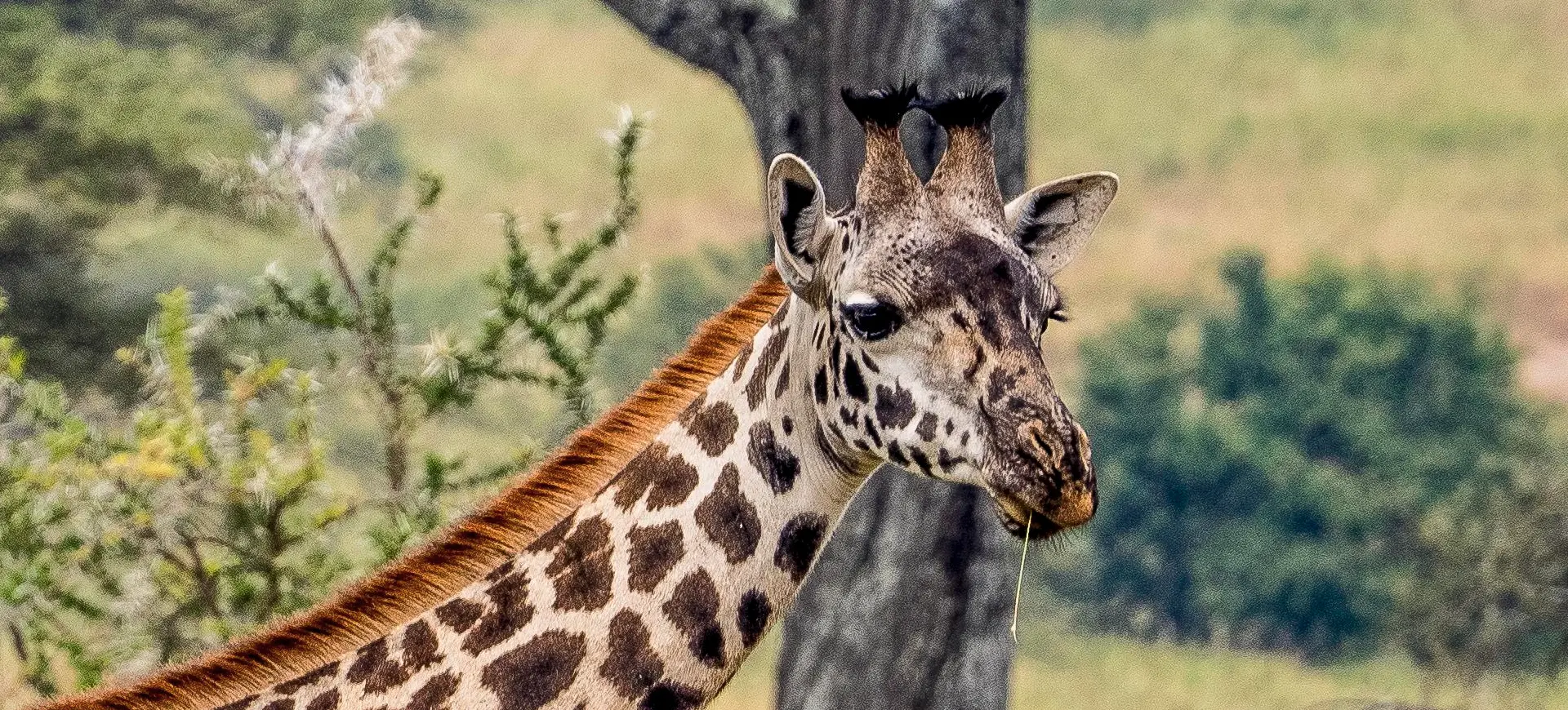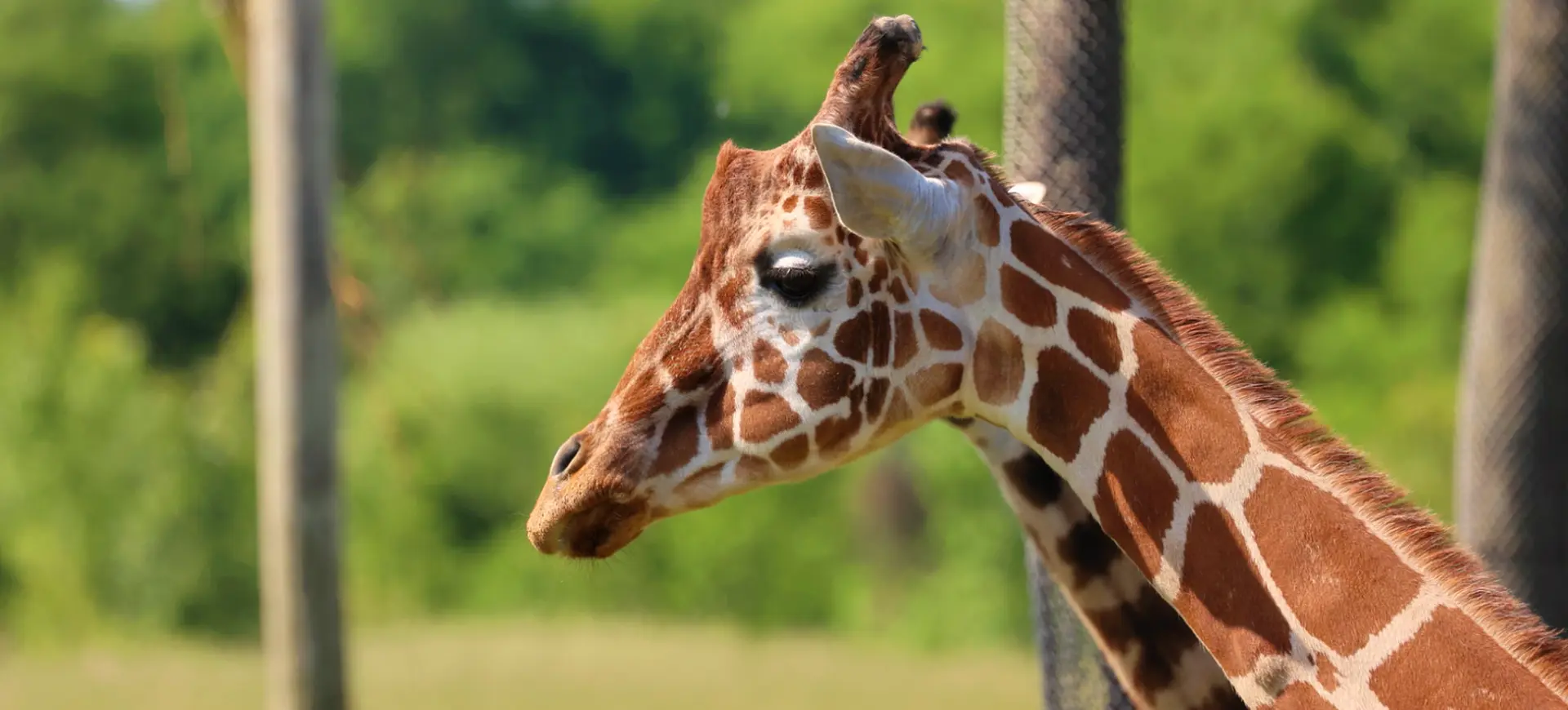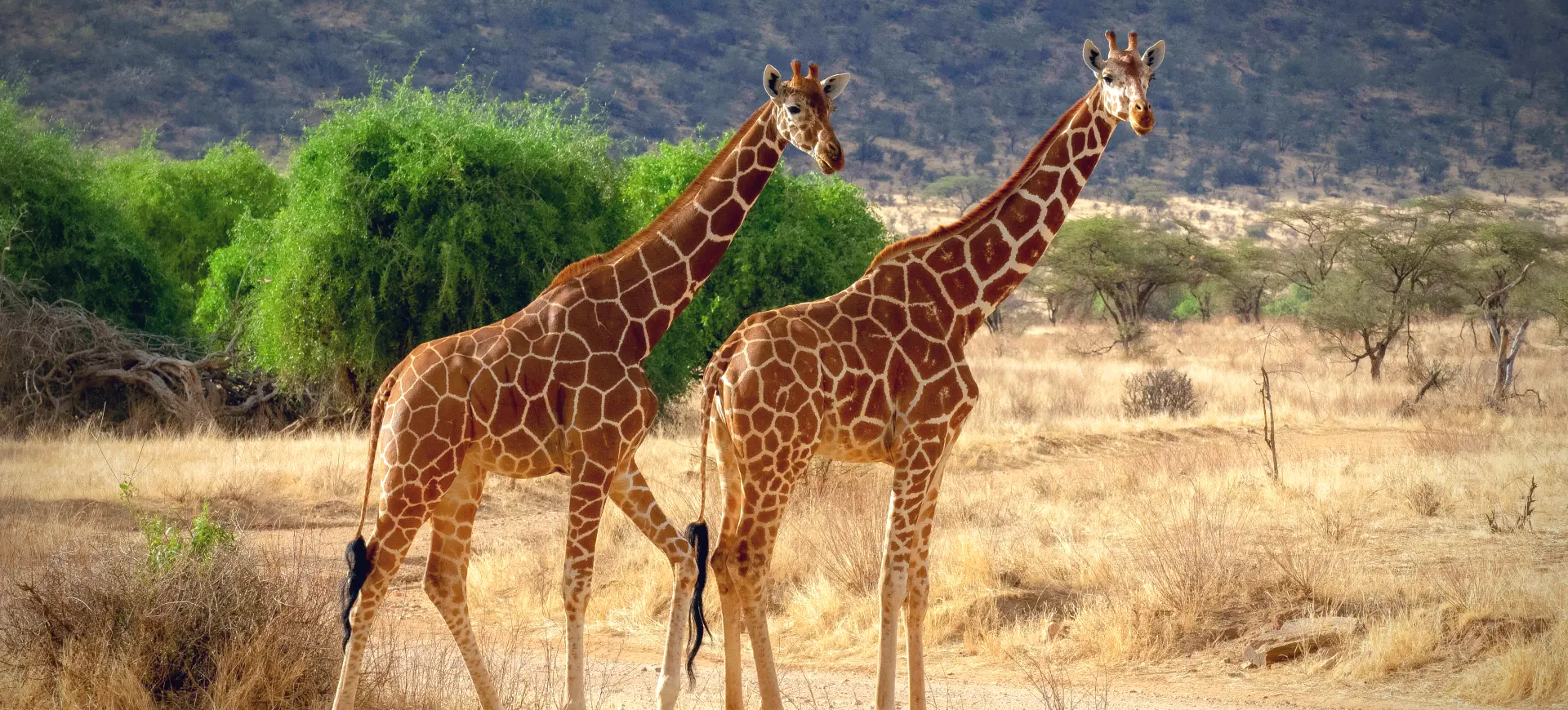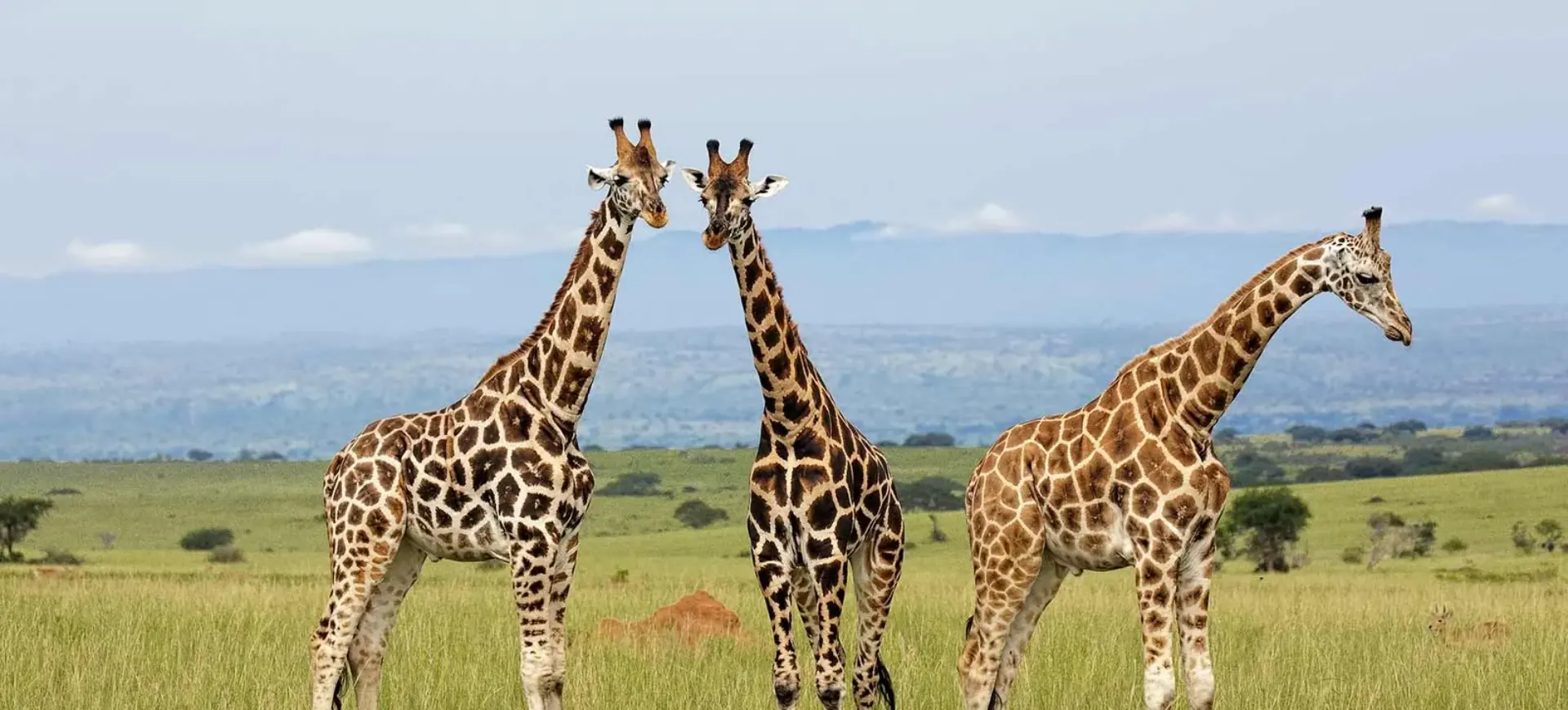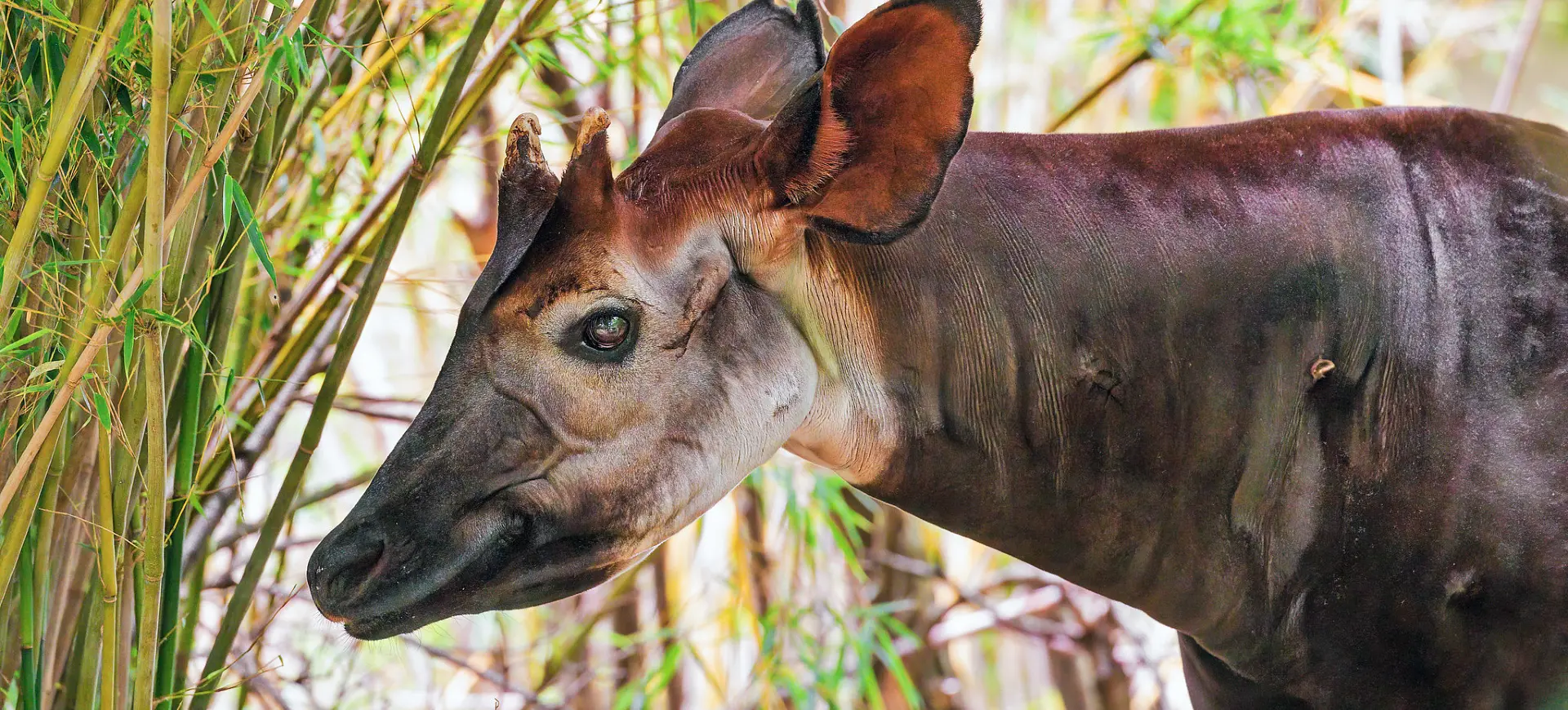Overview
The Nubian giraffe, or Giraffa camelopardalis camelopardalis, is one of the nine subspecies of giraffes, claiming the title of the tallest living terrestrial animal and the largest ruminant. Originating from East Africa, it stands apart from other giraffe subspecies due to its distinctive coat pattern. The patchwork of large, chestnut-brown spots that adorn its skin gives the Nubian giraffe its unique appearance. Surrounded by an off-white, creamy color, these spots starkly contrast the orange or lighter brown shades typically observed in other giraffe subspecies. The patches’ patterns become increasingly irregular and less defined, like a jigsaw puzzle, as they extend toward the inner legs.
Dietarily, Nubian giraffes are herbivores specializing in feeding on the leaves of acacia, mimosa, and wild apricot trees. Their long, prehensile tongues are perfect for reaching high into the treetops and skillfully maneuvering around thorns to access their food source. This anatomical feature makes them adept at thriving in environments where other herbivores may struggle to find nourishment.
Despite their towering stature, Nubian giraffes are known for their social nature and are often spotted in small, open herds. Their size does not hamper their agility; they are surprisingly swift creatures. They can muster short bursts of speed, reaching up to 35 mph, demonstrating a graceful agility that contrasts with their imposing size.
Taxonomy
Kingdom
Phylum
Class
Order
Family
Genus
Species
Sub Species
Type
Physical Description:
The Nubian giraffe’s height can range between 16-20 feet (males) and 14-16 feet (females), with males being generally taller and heavier. They can weigh between 2,400 and 3,000 pounds (males) and 1,600 and 2,600 pounds (females). With its long neck and legs, the Nubian giraffe has an impressively tall and elegant stature. Despite having such a long neck, like all giraffes, the Nubian giraffe has seven neck vertebrae, the same number as humans. The vertebrae are, however, much larger and linked by ball-and-socket joints for added flexibility.
Their most notable characteristic, the coat, is composed of large, four-sided spots of chestnut brown on a white to cream-colored background. These patches, polygonal in shape, are not as simple and smooth as those seen in other giraffe subspecies but have rough, irregular edges. Another distinguishing feature is their lower legs, which appear to be ‘stocking-like’ due to the absence of patterns.

Lifespan: Wild: ~25 years || Captivity: ~30 years

Weight: Males: 2400-3000 lbs (1088-1361 kg) || Females: 1600-2600 lbs (726-1180 kg)

Length: Male: 13 ft (4 m) || Female: 12 ft (3.7 m)

Height: Males: 16-20 feet (488-610 cm) || Females: 14-16 feet (427-488 cm)

Top Speed: 35 mph (56 km/h)
Characteristic:
Native Habitat:
Nubian giraffes inhabit the savannas, grasslands, and open woodlands of East Africa, particularly in Kenya, Uganda, South Sudan, and Ethiopia. They prefer regions with plenty of acacia growth, which provides their main food source. This subspecies has adapted to various environments across this range, from dry savannas to rainforests. Their habitats often overlap with human settlements, leading to conflicts for resources.
The Nubian giraffe’s range and population have declined significantly due to human activities, primarily habitat loss from agriculture and deforestation. This disruption to their natural environment has affected their food source and created barriers to their migratory paths and breeding areas. This fragmentation has led to isolated populations, hindering their genetic diversity.
Climate Zones:
Biomes:
Biogeographical Realms:
Continents:
Countries:
Diet:
Diet & Feeding Habits:
Like all giraffes, Nubian giraffes are browsers, meaning they eat leaves, shoots, and fruits of trees. They have a particular preference for acacia and mimosa trees, which are commonly found in their habitat. They use their long necks and legs to reach food inaccessible to other herbivores, and their equally long, prehensile tongues, often reaching up to 18 inches, help them pull down leaves growing high in the tree canopy and navigate around thorny obstacles.
These giraffes have a unique method of feeding called the “high-browser” system. With this, they feed from the tops of trees, reducing competition with other herbivores that feed at lower levels. Additionally, giraffes are ruminants, which means they have a four-chambered stomach that allows them to ferment consumed food before regurgitation and re-chewing, a process known as “chewing cud.” Despite their large size, their diet of leaves and branches means they don’t need to drink water daily, gaining most of their water from their food.
Mating Behavior:
Mating Description:
Nubian giraffes have no defined mating season, and breeding can occur year-round. When a female is in estrus, males compete for her attention through a behavior known as “necking,” where they swing their necks at each other to land blows with their heads. The one standing is considered the winner and earns the right to mate with the female.
Gestation for a Nubian giraffe lasts around 15 months, after which the female gives birth to a single calf, though twins are occasionally born. Remarkably, the mother gives birth standing up, so the calf’s first-world experience is a two-meter drop to the ground. This fall breaks the umbilical cord and helps the calf breathe.
Reproduction Season:
Birth Type:
Pregnancy Duration:
Female Name:
Male Name:
Baby Name:
Social Structure Description:
Nubian giraffes are social creatures, often found in open herds that lack the rigid structure seen in many other animal societies. The composition of these groups often changes, with individuals freely moving between different herds. However, they typically gather in groups of about 15, with females usually seen with their young, while males form their groups or roam alone.
Despite their social nature, giraffes are relatively silent, and most of their communication is believed to be visual. However, recent studies suggest they communicate infrasonically, with frequencies too low for human ears. They are generally peaceful animals, but males will participate in bouts known as “necking” to establish dominance and the right to mate with females in estrus.
Groups:
Conservation Status:
Population Trend:
The Nubian giraffe population in the wild is currently fragmented across East Africa, with an estimated count of approximately 3,000 individuals remaining, including the closely related Rothschild’s giraffe. This marked decline in their population can be attributed to persistent threats such as poaching and significant habitat loss, which have severely impacted their numbers and distribution.
Nowadays, the subspecies are mainly located within a handful of protected areas, where their existence is relatively safeguarded, and conservation efforts are particularly focused. These reserved habitats provide an essential refuge for these magnificent creatures, mitigating the threats they face in the wild and offering a glimmer of hope for preserving their species.
Population Threats:
The survival of Nubian giraffes is primarily threatened by habitat loss resulting from agricultural expansion, illegal hunting, and civil unrest within parts of their range. Agricultural practices have encroached upon their natural habitats, reducing the space and resources available to these towering creatures. Illegal hunting also presents a significant challenge, directly impacting their population numbers.
These issues, combined with the impacts of civil unrest, have substantially reduced the Nubian giraffes’ historical range. The resulting fragmentation of their populations directly reduces their numbers and increases the likelihood of inbreeding. This inbreeding can lead to a dangerous decrease in genetic diversity, undermining the population’s resilience and exacerbating the risk of a further decline in their numbers.
Conservation Efforts:
Several national parks and reserves across the range of Nubian giraffes provide them with protected habitats, working in tandem with numerous conservation initiatives to ensure the survival of their populations. These measures include various strategies, such as habitat restoration, rigorous anti-poaching efforts, and community-based conservation projects. These initiatives aim to create an environment conducive to their survival and growth, minimizing the threats they face.
Further, ongoing scientific studies striving to better understand the Nubian giraffe’s behavior, ecology, and specific needs are instrumental in devising effective conservation strategies. In Uganda, a dedicated initiative, the Rothschild’s Giraffe Project, concentrates on conserving the Nubian giraffe. This is achieved through comprehensive research into the species and community outreach, fostering an environment of coexistence and mutual respect between humans and these majestic creatures.
Additional Resources:
Fun Facts
- Giraffes are the tallest animals on Earth.
- Despite their long necks, giraffes have the same neck vertebrae as humans – just seven.
- A giraffe’s tongue can be up to 18 inches long.
- Giraffes can go without drinking for weeks at a time.
- They can run at speeds of up to 35 miles per hour.
- Giraffes sleep for just a few minutes at a time, and in total, no more than 30 minutes per day.
- Female giraffes give birth standing up.
- A newborn giraffe is about 6 feet tall.
- Giraffes have a special valve in their neck to prevent blood rushing to their head when they bend down.
- Giraffes have excellent eyesight, which combined with their height, allows them to spot predators from far away.






